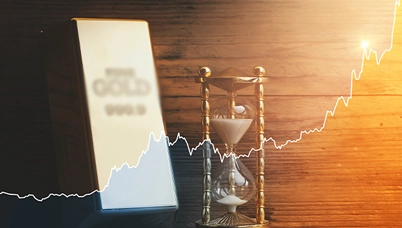Gold ends year with 7% surge as dollar falls
Posted On Wednesday, Dec 27, 2017
“Déjà vu” – gold market in 2017 seemed like 2016 all over again. The first half saw gold prices move up gradually only to give away some gains at the end of the year. The correction from middle of September was attributed to optimism surrounding rate hikes. As the U.S. stock market hit numerous records and optimism grew over President Donald Trump’s tax reform helped sustain the declining momentum. Gold prices pared performance, ending the year with +7% gains aided by weakness in dollar. Not only were the gains better as compared to the low yielding fixed income instruments in the developed world, but also proved resilient in a risk on environment where equities kept ticking higher to record levels each day.
Central banks continue with their monetary experiment of adding liquidity which is nothing but fueling asset markets, suppressing volatility and in process has temporarily created an uneasy calm in financial markets. The frivolity is reflected in equity and bond markets globally where risk has been completely mispriced. Equities are looked upon as without an alternative, trillions of dollars are yielding negative today and credit spreads are at historic low levels. It wasn’t just the Federal Reserve; the European Central Bank (ECB) and the Bank of Japan have both grown their balance sheets more than the US has. With the newly created money they have been bidding asset prices higher. The Bank of Japan openly deals in the forex, debt and equity markets, buying ETFs on a very regular basis and becoming one of Japan’s largest public shareholders. The ECB has spared any bond it can justify buying under its rules. According to Business Insider, global central banks are on pace to purchase an astounding 3.6 trillion dollars in stocks and bonds in 2017. The economic boom created by monetary inflation and suppression of interest rates has led to false impression of a healthy economy.
Rekindled hopes for a US renaissance resulting from a supposedly pro-business, nationalistic reflation policy were able to generate the required change in sentiment which bodes well for asset prices but does little for the real economy. The so called Tax reform is the biggest example which increases the deficit, is regressive, and will further widen income inequality. Most CEOs say they will use any tax savings for stock buybacks or dividends, not new hiring or expansion. It leaves low- and middle-income workers with no meaningful tax benefit and hence does little good for overall economy. This means the current ebullience on Wall Street relating to growth optimism is about as far offside as possible.
The dollar rallied for many years on the prospect of Fed tapering. When it ultimately started, the dollar fell. Now we’ve started the process of taper talk at the ECB, driving dollar weakness. This cyclical phenomenon has been a strong factor helping gold besides investors buying gold for diversification on economic and geopolitical worries.
Outlook
The trickle-down theory applied by central banks in the hope that by giving boost to asset prices they would create wealth that would further trickle down to the bottom 50% of the US population or to Main Street. In reality, it did little to boost consumption and largely increased disparity by benefitting the asset owners’ i.e. the wealthy. As a result, US stock market as a percentage of GDP is now far bigger than it was at the housing bubble’s peak, and it’s rapidly approaching the dot-com bubble peak.
We believe that the absence of the often-quoted sustainable economic recovery is one factor to blame for the seeming reluctance at the Fed. The number of people sitting on the sidelines rather than looking for work understates an unemployment rate that counts only those who are actively looking for work but can’t find it. Total consumer debt as a percentage of disposable income is the highest it has ever been – over 26%. The savings rate has fallen to a 10-year low. Consumers are stretched, and there is just not the buying power. The drivers of this year’s growth are probably transient; and that the structural foundation of the US economy is weakening. The cost of living for people at the median income level and below is outpacing wage growth and leaving the average household struggling to stay even. The continuing declining trend in bank loan growth combined with the flattening of the yield curve does raise eyebrows over the cyclical optimism that Fed often states. The outlook for the economy isn’t as upbeat as it seems on surface. We might be staring at peak growth and will probably see an incremental decline in economic growth rates over the course of next year and further.
However, the Fed seems to be keen to use the new euphoria on the markets in order to push the normalisation of monetary policy. We don’t expect real rates to move up too much. After the December increase in rates, there would perhaps be another two hikes in 2018 at maximum. But we think there is a considerable risk that there will only be one more hike next year. By contrast, the so-called dot-plot of individual policymakers shows they envision three more next year.
Should the current expansion fail to become the longest in history and US GDP growth indeed turn downward over the next year, we believe the consequences could be grave. The knee-jerk reaction by the government and the Fed would definitely comprise renewed stimulus measures in order to stem the downfall, which implies a complete U-turn in monetary policy. Currently, financial markets are almost exclusively focused on the planned normalization of monetary policy. Almost no-one seems to expect an impending recession or a return to loose monetary policy. Investors will do well to remember that, so far, the Fed has been behind the curve and only delivered when markets brought it on a silver platter. Since the normalization of monetary policy hasn't progressed sufficiently yet, renewed stimulus measures would probably shake market confidence in the efficacy and sustainability of the unconventional monetary experiments applied to date.
It remains undisputed that significant low-cost liquidity drives asset prices higher. Logically, it also makes perfect sense that the withdrawal of this low-cost liquidity would also impact asset prices in the opposite direction. As we get closer to a much wider monetary tightening next year with $420 billion to be sucked out by the Fed and about $500 billion less in the way of buying from the European Central Bank. The impact of lesser money will be over time felt by the markets until then we expect the euphoria on tax cut optimism, liquidity and higher asset prices to continue for some more time in the next year and will likely recede by the second half of the year and that is when gold should really start doing well.
The debt markets globally have not improved since the Global Financial Crisis. They have gotten more problematic. Like, for years, European governments have kicked the can down the road building up their debts thanks to the extremely expansionary monetary policies of the ECB. The structural problems like over-indebted governments, bubble sized public sectors, public debt loaded insolvent banking sectors or inflexible labor markets have not been solved. Indeed, the ECB´s policies permitted to delay the solution of these problems. Even China’s delicate rebalancing between deleveraging and growth is fret with risks. There are several threats to present global macroeconomic conditions, ranging from heightened political risks, massive increases in global debt, erroneous central bank and government policies. At the other end, Bitcoin’s surge is attracting investor interest toward the cryptocurrency and it is clear that money that might otherwise have gone into gold plays of late has been attracted to the crypto bubble phenomenon. However, Stocks and cryptocurrencies both could end up being supportive influences for gold. Both investment demand and prices will rise further the next time the economic and political environment inspires investors to rush even more dramatically back to gold.
The world continues to remain in state of great disequilibrium, both with respect to the global economy and geopolitics as well. The fallout of the geopolitics globally seems to now cap the downsides in gold. Given the macroeconomic picture, gold will be a useful portfolio diversification tool and thereby helping you to reduce overall portfolio risk.
Data Source: Bloomberg, World Gold Council
Disclaimer, Statutory Details & Risk Factors:
The views expressed here in this article / video are for general information and reading purpose only and do not constitute any guidelines and recommendations on any course of action to be followed by the reader. Quantum AMC / Quantum Mutual Fund is not guaranteeing / offering / communicating any indicative yield on investments made in the scheme(s). The views are not meant to serve as a professional guide / investment advice / intended to be an offer or solicitation for the purchase or sale of any financial product or instrument or mutual fund units for the reader. The article has been prepared on the basis of publicly available information, internally developed data and other sources believed to be reliable. Whilst no action has been solicited based upon the information provided herein, due care has been taken to ensure that the facts are accurate and views given are fair and reasonable as on date. Readers of this article should rely on information/data arising out of their own investigations and advised to seek independent professional advice and arrive at an informed decision before making any investments. Please visit – www.quantumamc.com/disclaimer to read scheme specific risk factors.
Related Posts
-

Understanding GIPS: The Global Standard for Performance Reporting
Posted On Wednesday, Jan 14, 2026
In the world of investing, everyone loves a good performance number.
Read More -

Equity Monthly for January 2026
Posted On Friday, Jan 02, 2026
Indian markets remained range-bound in 2025
Read More -

Gold Monthly for January 2026
Posted On Thursday, Jan 01, 2026
Gold Market Review and Outlook: 2025–2026
Read More



